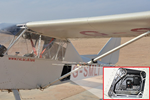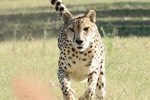Mr John Lowe
Department: Comparative Biomedical Sciences
Campus: Hawkshead
Research Centres: Structure & Motion Laboratory
John is an electronics and software design engineer, focusing on the design and implementation of custom electronic systems to support the research carried out within the Structure & Motion Lab.
John's main focus is the design and implementation of custom electronic systems and devices to support the research carried out within the Structure & Motion Lab.
Current work is focused on the design and deployment of advanced location and activity monitoring collars to track the grazing and migratory activity of populations of zebra, wildebeest, and other herbivores in the Okavango Delta in Botswana. Additional work has involved the design and integration of electronic systems in the Lab’s aerial survey aircraft, based in Botswana, which is used for large-scale aerial LiDAR and photogrammetric survey of the Botswana habitat.
Other recent work has involved the application of similar collar technology to investigate the hunting behaviour and locomotion dynamics of wild cheetah, leopard, lion, and African hunting dogs, again in the Okavango Delta region, as part of a collaborative project with the Botswana Predator Conservation Trust. Previous work has included miniaturised GPS/Inertial logging systems for investigations into bird flight dynamics.
John is a member of the Institution of Engineering and Technology.
- Wilson AM, Hubel TY, Wilshin SD, Lowe JC, Lorenc M, Dewhirst OP, Bartlam-Brooks HLA, Diack R, Bennitt E, Golabek KA, Woledge RC, McNutt JW, Curtin NA, West TG. Biomechanics of predator-prey arms race in lion, zebra, cheetah and impala. (2018) Nature. 554: 183-188.
- Wilson AM, Lowe JC, Roskilly K, Hudson PE, Golabek KA, McNutt JW. Locomotion dynamics of hunting in wild cheetahs. (2013). Nature. 498: 185-189.
- Usherwood JR, Stavrou M, Lowe JC, Roskilly K, Wilson AM. Flying in a flock comes at a cost in pigeons. (2011). Nature. 474: 494-497.
-
AIRSCAN
The AIRSCAN project uses a modified research aircraft for aerial survey and data acquisition. During its first deployment in the LOCATE project, the aircraft allowed us to understand more about behaviour and locomotion in wild, free-ranging animals in southern Africa. The on-board technology helped reveal new insights into how animals interact with their natural environment, which will aid conservation and land management. The modified aircraft was originally built for studying large African carnivores and their prey in the savannah of northern Botswana. The researchers developed new ways of recording the detailed movements of these animals without disturbing them, using our wildlife tracking collars.
-
LOCATE: Locomotion, hunting and habitat utilisation among large African carnivores and their prey
LOCATE: Locomotion, hunting and habitat utilisation among large African carnivores and their prey. The carnivores of the southern African savannah have no domestic counterparts and are at the extremes of performance in terms of speed, agility and strength. They are amongst the most threatened species in the world and yet there is much we do not know about them. At the beginning of this project, we did not know how the predators or their prey achieve the speed and manoeuvring required for the chase, what makes the difference between success and failure in hunting or how far the animals travel in a day or night and many other factors that may influence success and survival.


